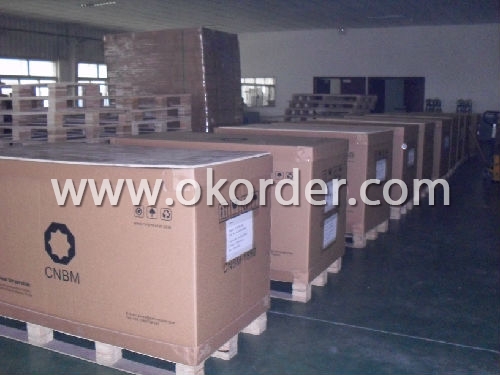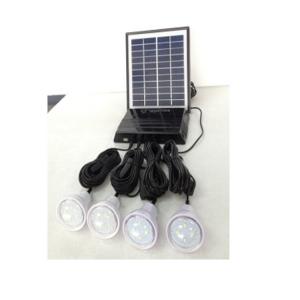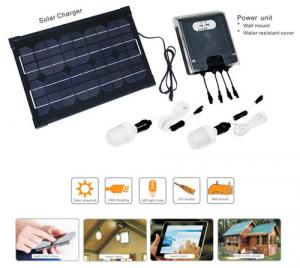Solar Energy Systems Perth WA CNBM-K2 (80W) Solar Home System
- Loading Port:
- China Main Port
- Payment Terms:
- TT
- Min Order Qty:
- 1 set set
- Supply Capability:
- 1000 sets per month set/month
OKorder Service Pledge
OKorder Financial Service
You Might Also Like
Brief Introduction of Solar Home System CNBM-K2 (80W)
CNBM Home System-K2 (80W) has a wonderful capacity.It can be used in factory,home,school and other CNBM Home System-K2 (80W) consist of the solar modules,charge controller,inverter and battery banks.
CNBM International is highly recognized by its business partners and clients all over the world and has obtained rapid development under the spirit of win-win .
With CNBM Home SystemK2 (80W),We will carry on the mutual beneficial,innovative and revolutionary trading structure as we did before,create value for our employees,share holders and clients and benefit the whole society in our future development.Please contact us ,if you have interest in CNBM Home System-K2 (80W),don’t hesitate!
The Sketching of Solar Home System CNBM-K2 (80W)

Components of Solar Home System CNBM-K2 (80W)
PV Array:
Convert sunlight instantly into DC electric power. Formed by the solar modules (also called photovoltaic modules) in accordance with the system requirements for series and parallel.
Solar Charge Controller:
A charge controller may be used to power DC equipment with solar panels. The charge controller provides a regulated DC output and stores excess energy in a battery as well as monitoring the battery voltage to prevent over charge or over discharge. An inverter can be connected to the output of a charge controller to drive AC loads.
Inverter:
Converts DC output power of photovaltaic soalr panels into standard AC power for use in the local off-grid electrical network. It is a critical component in a photovoltaic system, allowing the use of ordinary commercial appliances.
Battery banks:
Stores energy when there is an excess coming in and distribute it back out when there is a demand. Solar PV panels continue to re-charge batteries each day to maintain battery charge.
Technical data of Solar Home System CNBM-K2 (500W) | ||
Inverter | Rated load power | 500W |
Output wave | Modify sine wave | |
Output voltage | DC 12V | |
Output frequency | DC:12V AC:220V | |
Precision of output | 50HZ/60HZ | |
Precision of output frequency | ±6% | |
Solar panel | Pmax | 80W |
Vmp | 17.8V | |
Imp | 4.49A | |
Charger | Charger voltage & current | 12V 10A |
Battery | Capacity | 12V 40AH |
Power box | Spray paint iron box,with input,output,ammeter,voltmeter,master swith and so on. | |
Package of Solar Home System CNBM-K1 (60W) | ||||
Part | Size(L*W*H mm) | Weight(kg) | 20’(pcs) | 40’(pcs) |
Power box | 580*280*540 | 50 | 120 Sets | 280 Sets |
Solar panel | 890*670*30 | 8 | ||
Battery | 200*180*170 | 15 | ||
Factory Picture of Solar Home System CNBM-K2 (80W)

Package Picture of Solar Energy System CNBM-K2 (80W)

- Q: How does the installation of solar panels affect the building's resale value?
- Installing solar panels can positively impact a building's resale value. Potential buyers are increasingly interested in energy-efficient features, and solar panels can significantly reduce electricity costs. Additionally, solar panels demonstrate a commitment to sustainability, which appeals to environmentally conscious buyers. Overall, the installation of solar panels can make a building more attractive, potentially leading to a higher resale value.
- Q: Are there any risks of electrical surges or voltage fluctuations with solar energy systems?
- Solar energy systems come with potential risks of electrical surges or voltage fluctuations. Although the solar panels themselves do not cause these issues, integrating the systems with the existing electrical grid can present challenges. One risk arises from sudden changes in sunlight intensity, which can lead to voltage fluctuations. For instance, when a cloud passes over a solar panel, the abrupt decrease in sunlight can result in a drop in voltage output. Conversely, when the cloud passes, the sudden increase in sunlight can cause a surge in voltage output. These fluctuations have the potential to impact the stability of the electrical grid. Another risk is associated with the inverters utilized in solar energy systems. Inverters convert the direct current (DC) produced by solar panels into alternating current (AC), which is compatible with the electrical grid. Inverter failure or malfunction can cause voltage fluctuations or surges, potentially damaging electrical equipment or disrupting the electrical supply. To address these risks, solar energy systems typically include protective devices such as surge protectors and voltage stabilizers. Surge protectors divert excess energy away from the system to prevent voltage spikes, while voltage stabilizers regulate voltage levels to ensure a steady and safe supply of electricity. Furthermore, proper installation and regular maintenance of solar energy systems are crucial in minimizing the risks of electrical surges or voltage fluctuations. Qualified professionals should handle the installation process, ensuring correct connections and grounding of all components. Routine inspections and maintenance checks can help identify and resolve any issues before they escalate into serious problems. In conclusion, while solar energy systems offer many benefits, it is important to acknowledge and address the potential risks associated with electrical surges or voltage fluctuations. By implementing suitable protective devices, following proper installation and maintenance procedures, and collaborating with qualified professionals, these risks can be effectively managed, guaranteeing the safe and reliable operation of solar energy systems.
- Q: Do solar energy systems require surge protection?
- Indeed, surge protection becomes imperative when it comes to solar energy systems. The susceptibility of these systems to power surges caused by lightning strikes, grid fluctuations, or other electrical disturbances necessitates the presence of surge protection. The fragile electronic components of a solar energy system, like inverters or charge controllers, can be severely compromised or even annihilated by power surges. Hence, the deployment of surge protection devices, such as surge protectors or surge arresters, is crucial in diverting excessive voltage away from the system, thereby safeguarding it from harm and ensuring its durability. Furthermore, the inclusion of surge protection is often mandated by electrical codes and regulations to guarantee the safety and dependability of solar energy systems.
- Q: Can solar energy systems be used in areas with extreme temperatures?
- Yes, solar energy systems can be used in areas with extreme temperatures. However, the performance and efficiency of these systems may be affected by extreme heat or cold. Proper design and maintenance are essential to ensure optimal performance in such conditions.
- Q: How does the angle of solar panels affect their performance?
- The angle of solar panels significantly affects their performance. The optimal angle for solar panels is typically determined by the latitude of the installation site. If the angle is too steep, sunlight may be reflected away, reducing the overall energy output. Conversely, if the angle is too shallow, the panels may not receive the maximum amount of sunlight, resulting in decreased efficiency. Therefore, choosing the correct angle is crucial to ensure optimal solar panel performance and maximize energy generation.
- Q: Can solar energy systems be installed on floating structures?
- Yes, solar energy systems can be installed on floating structures. Floating solar panels, also known as floating photovoltaic (FPV) systems, are becoming increasingly popular as a sustainable solution for harnessing solar energy. These systems can be installed on various floating structures like reservoirs, lakes, and even oceans. They offer several advantages such as increased energy production due to the cooling effect of water, reduced land use, and the potential to utilize underutilized water bodies for renewable energy generation.
- Q: Can solar energy systems be used in areas with limited access to distribution networks?
- Yes, solar energy systems can be used in areas with limited access to distribution networks. Off-grid solar systems, also known as standalone systems, can be installed in remote areas without access to traditional electricity grids. These systems generate and store electricity through solar panels and batteries, enabling users to have a reliable and sustainable source of power even without being connected to distribution networks. Off-grid solar energy systems have proven to be an effective solution for providing electricity to communities in remote locations, thus helping to bridge the energy access gap.
- Q: Can solar energy systems be installed in areas with extreme weather conditions?
- Yes, solar energy systems can be installed in areas with extreme weather conditions. However, the performance and durability of the system may vary depending on the specific weather conditions. Proper design, installation, and maintenance can help ensure that solar systems can withstand extreme weather events such as hurricanes, snowstorms, or high winds. Additionally, advancements in solar technology have made it possible to adapt systems to various weather conditions, making solar energy a viable option in areas with extreme weather.
- Q: Are solar energy systems reliable?
- Yes, solar energy systems are reliable. They have proven to be a dependable and consistent source of renewable energy, with advancements in technology making them more efficient and durable.
- Q: Do solar energy systems require a backup battery system?
- Depending on your specific needs and circumstances, it may be beneficial to have a backup battery system for your solar energy system. Solar energy systems generate electricity from the sun and can be connected to the grid, allowing excess energy to be sold back to the utility company. This means that even during times when the sun is not shining, such as at night or during cloudy weather, you can still draw electricity from the grid. However, there are several advantages to having a backup battery system. Firstly, it enables you to store excess energy generated during the day for use at night or during power outages. This ensures a reliable source of electricity even when the grid is down. Moreover, a backup battery system provides a more consistent power supply. When connected to the grid, solar energy systems typically shut down during power outages to protect utility workers. But with a backup battery system, you can continue powering your essential appliances and devices during these outages. Additionally, having a backup battery system promotes energy independence. By storing your own energy, you can reduce dependence on the grid and potentially further offset electricity bills. Ultimately, the decision to install a backup battery system for your solar energy system depends on your specific energy needs, budget, and preferences. Seeking guidance from a solar energy professional can help you determine the best solution for your situation.
Send your message to us
Solar Energy Systems Perth WA CNBM-K2 (80W) Solar Home System
- Loading Port:
- China Main Port
- Payment Terms:
- TT
- Min Order Qty:
- 1 set set
- Supply Capability:
- 1000 sets per month set/month
OKorder Service Pledge
OKorder Financial Service
Similar products
Hot products
Hot Searches
Related keywords



























